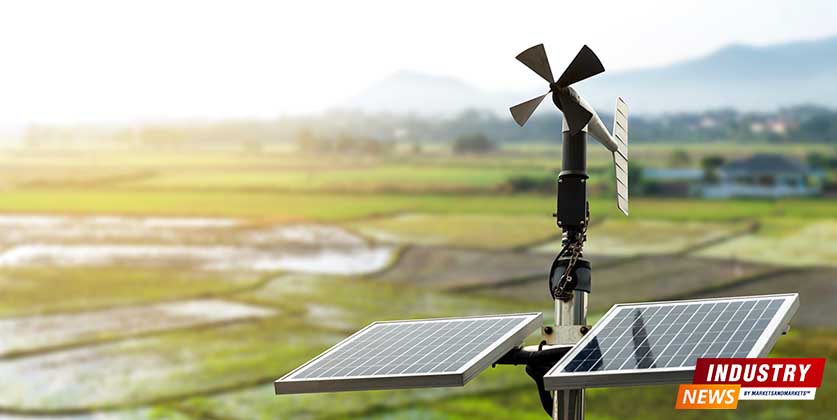US Small Scale Solar Capacity Breaks Record 6.4 Gigawatts

This News Covers
- Which other 5 industries which depend upon AI will get impacted because of this?
- How this is going to impact top 5 industries?
- Top 5 countries which are going to get impacted due to this?
- What will be the impact of this deal in next 5 years at global level?
- How is this going to impact top 5 companies in North America?
U.S. Energy Information Administration (EIA) reported on September 11, 2023 that the United States added a record 6.4 gigawatts (GW) of small-scale solar capacity in 2022. This is the highest amount added in a single year.
MarketsandMarkets welcomes this development and we take a look at the details here.
The Record Breaking Small Scale Solar Capacity Built in United States
Small-scale solar, often referred to as distributed or rooftop solar, pertains to solar-power systems with a capacity of 1 megawatt (MW) or less.
The majority of this capacity comes from rooftop solar panels on homes, but it's also prevalent in the commercial and industrial sectors. Since 2014, when the EIA began publishing these estimates, small-scale solar capacity in the U.S. has grown from 7.3 GW to 39.5 GW in 2022, constituting about one-third of the total solar capacity in the country.
Factors like tax credits, incentives, public policies, and higher retail electricity prices have spurred the growth of small-scale solar capacity over the past decade. Additionally, the decreasing costs of solar panels have significantly contributed to this growth. California leads the nation with 36% of the country's small-scale solar capacity, driven by its abundant sunshine, favorable incentives, and relatively high retail electricity prices. New York and New Jersey follow, but Texas and Arizona are catching up. When adjusted for population size, Hawaii has the highest small-scale solar penetration, with 541 watts per capita, largely because of its historical reliance on expensive oil-fired power plants and its goal to achieve 100% renewable energy by 2045.
Analysis:
- Growth Momentum: The rapid growth in small-scale solar capacity, from 7.3 GW in 2014 to 39.5 GW in 2022, indicates a strong momentum in the renewable energy sector. This growth is a positive sign for investors and stakeholders in the solar industry.
- Economic Drivers: The combination of tax credits, incentives, and falling solar panel costs has made solar installations more economically viable for homeowners and businesses. This trend is expected to continue, especially if solar panel costs continue to decrease.
- State Policies: California's policies, such as the Net Energy Metering Program and the mandate for new homes to have solar panels, showcase how state-level initiatives can significantly influence energy markets. Other states might consider adopting similar policies to boost their renewable energy portfolios.
- Diversification of Energy Sources: States like Hawaii, which have historically relied on expensive energy sources like oil, are diversifying their energy mix. This not only reduces energy costs for consumers but also enhances energy security by reducing dependence on imported fuels.
- Market Potential: The fact that states with less sunshine, like New York and New Jersey, have significant small-scale solar capacities indicates that the potential market for solar is vast. It's not just limited to traditionally sunny states.
- Future Outlook: With states setting ambitious renewable energy targets, like Hawaii's goal of 100% renewable energy by 2045, the demand for solar and other renewable energy sources is expected to grow. This presents numerous opportunities for businesses, investors, and policymakers in the energy sector.
Small-Scale vs. Large-Scale Solar: A Comparative Analysis
While both solar categories tap into solar energy, their capacity, application, and impact vary. Each holds its merit and is instrumental in steering the global shift towards sustainable energy. As per the U.S. Energy Information Administration, solar energy, both small and large-scale, is pivotal in meeting energy demands and reducing carbon footprints. Their combined efforts are integral to a sustainable energy future.
The solar industry has witnessed significant growth, with installations ranging from individual rooftops to vast desert expanses. The distinction between small-scale and large-scale solar is crucial in understanding their respective roles in the energy landscape. Here's a comprehensive analysis of their differences:
Comparison:
- Small-Scale Solar: According to the Clean Energy Regulator of Australia, small-scale solar systems typically have a capacity of up to 100 kilowatts (kW). These installations are often found on residential rooftops, commercial buildings, and small plots of land. Montgomery County's guidelines further emphasize that these systems are designed primarily for on-site consumption.
- Large-Scale Solar: These are installations with capacities exceeding 100 kW, often spanning several hundred megawatts (MW). Large-scale solar farms or parks are designed to generate electricity on a massive scale, primarily for sale to utilities or the grid.
Size and Capacity:
- Small-Scale Solar: These systems, often in the kilowatt (kW) range, have a capacity of up to 1 megawatt (MW). They cater to localized energy needs.
- Large-Scale Solar: Exceeding 1 MW, these utility-scale installations can span several hundred MWs, aiming to produce electricity on an industrial scale.
Application:
- Small-Scale Solar: Predominantly distributed or rooftop solar, they're found on residential rooftops, commercial establishments, or small land parcels.
- Large-Scale Solar: These expansive solar farms or parks are engineered to generate vast amounts of electricity, often for sale to utilities or the grid.
Location:
- Small-Scale Solar: Positioned at consumption points, they're integral to homes, educational institutions, or businesses.
- Large-Scale Solar: Strategically located in high solar potential areas, they often occupy vast tracts of land, especially in regions like deserts.
Grid Connectivity:
- Small-Scale Solar: Versatile in nature, they can be grid-tied, off-grid, or hybrid. Grid-tied variants enable users to sell surplus electricity back, while off-grid ones depend on battery storage.
- Large-Scale Solar: Predominantly grid-connected, they channel electricity directly to the utility grid, bolstering the region's energy supply.
Primary Objective:
- Small-Scale Solar: Designed to counterbalance the electricity usage of individual entities, they can curtail electricity expenses and offer backup power.
- Large-Scale Solar: Their primary aim is electricity generation for utilities, thereby augmenting a region's or nation's electricity reservoir.
Economies of Scale:
- Small-Scale Solar: The cost per watt might be on the higher side due to the limited scale of the installation.
- Large-Scale Solar: Their expansive nature allows for economies of scale, ensuring a reduced cost per watt, courtesy of bulk procurement and efficient installation methodologies.
Financing and Proprietorship:
- Small-Scale Solar: Ownership can be with homeowners, commercial entities, or third-party firms that lease the system.
- Large-Scale Solar: Typically, they're the assets of utility firms, independent power producers, or solar project magnates.
Environmental Footprint:
- Small-Scale Solar: Their integration with existing structures ensures minimal land disruption.
- Large-Scale Solar: Despite their extensive land requirements, which can have environmental ramifications, they play a pivotal role in offsetting fossil fuel consumption.
The New England Case Study
A surge in residential solar installations is driving New England's efforts to reduce greenhouse gas emissions.
The growth of distributed solar in New England is particularly noteworthy given the region's ambitious climate goals and challenges in building large-scale renewable projects. The emergence of residential solar has significantly aided the region in progressing towards its climate objectives. Massachusetts, for instance, has been a significant driver of this trend, accounting for about two-thirds of the behind-the-meter solar installations in the region.
However, the rapid growth of small-scale solar has also brought challenges. The region's grid has had to adapt to the changing dynamics of electricity demand and supply. For instance, ISO New England has noted that nighttime electricity consumption has, on several occasions, surpassed daytime demand, a trend that was unheard of a decade ago.
Top small scale solar companies in United States
Green Home Systems
Overview: Green Home Systems is a full-service solar provider that offers custom solar solutions tailored to individual needs. They emphasize the importance of using high-quality equipment and professional installation to ensure the best performance and longevity of the solar system.
Key Features:
- Custom solar solutions
- High-quality equipment
- Professional installation
- Emphasis on sustainability and reducing carbon footprint
Sunpro Solar (Now ADT Solar)
Overview: Sunpro Solar, now rebranded as ADT Solar, has been acquired by ADT Inc., a trusted brand in smart home and small business security. The acquisition aims to leverage ADT's national reach and brand trust to accelerate the expansion of solar solutions.
Key Features:
- Comprehensive 25-year warranty on panels, inverters, performance, and labor.
- Offers 24/7 support.
- Custom solar system design and installation.
- Roofing services through Buildpro.
- Solar panels from Q Cells, Silfab, and Canadian Solar.
- Solar battery options: Enphase IQ and Tesla Powerwall.
- A+ rating on BBB with mixed customer reviews.
Blue Raven Solar
Overview: Blue Raven Solar is a top residential solar company that focuses on providing affordable solar solutions. They have a unique BluePower Plus+ plan which offers 18 months of free solar power.
Key Features:
- BluePower Plus+ plan for 18 months of free solar power.
- Emphasis on quality, affordability, and boosting the U.S. economy.
- Founded in 2014 and has expanded rapidly.
SunPower:
Overview: SunPower is a global solar innovation leader that offers high-performance solar solutions. They have a long-standing reputation for premium solar panels that deliver unmatched reliability and durability.
Key Features:
- High-efficiency solar panels with a 25-year warranty.
- Complete solar solutions from panels to energy storage.
- Secured a $450 million financing commitment to support solar loan offerings.
- Emphasis on sustainability and innovation.
Broader Implications and Future Outlook
While small-scale solar plays a pivotal role in the renewable energy landscape, it's essential to understand its limitations. For instance, while distributed solar can significantly offset electricity consumption for individual users, achieving broader climate goals requires a more comprehensive approach. Large-scale renewable projects, such as wind farms and utility-scale solar installations, are crucial in this regard.
Both small-scale and large-scale solar systems play vital roles in the global transition to renewable energy. While they differ in capacity, application, and impact, their combined contribution is essential for a sustainable energy future. As regions like New England have shown, embracing both scales of solar energy can drive significant progress towards climate goals. However, achieving these goals will require a balanced approach, integrating both distributed and utility-scale renewable energy sources, and ensuring equitable access to their benefits.
GET AHEAD
Top Research Reports to Fuel Your Industry Knowledge- Next-Generation Solar Cell Market by Material Type (Cadmium Telluride (CdTe), Copper Indium Gallium Selenide (CIGS), Amorphous Silicon, Gallium-Arsenide, Others), Installation (On-Grid, Off-Grid), End User and Geography - Global Forecast to 2028
- Concentrating Solar Power Market by Technology (Solar Power Tower, Linear Concentrating System, Dish Stirling), Operation Type (Stand-alone, Storage), Capacity (<50 MW, 50-99 MW, 100 MW & Above), End User (Utilities, EOR), Region - Global Forecast to 2027
Editor's Pick


Healthcare
MiniMed™ 780G & Simplera Sync™: Smarter Tech, Simpler Lives for Diabetes Patients
Information and Communication Technology
Google Veo 2, Raising the Bar for AI Video GenerationPODCASTS

Sustainable Digital Transformation & Industry 4.0
Sanjay Kaul, President-Asia Pacific & Japan, Cisco, and host Aashish Mehra, Chief Research Officer, MarketsandMarkets, in conversation on unraveling 'Sustainable Digital Transformation and Industry 4.0'
11 July 2023|S2E12|Listen Now

Generative AI
Prasad Joshi, Senior Vice President-Emerging Technology Solutions, Infosys, and host, Vinod Chikkareddy, CCO, MarketsandMarkets, in exploring the recent advances in AI and the generative AI space.
7 Nov 2023|S2E13|Listen Now
Next-generation Solar Cell Market
Download Whitepaper
US Small-scale solar capacity grew from 7.3 GW to 39.5 GW in 2022
Both small-scale and large-scale solar systems play vital roles in the global transition to renewable energy
Highest capacity added in a single year
U.S. Energy Information Administration (EIA) reported on September 11, 2023 that the United States added a record 6.4 gigawatts (GW) of small-scale solar capacity in 2022.












